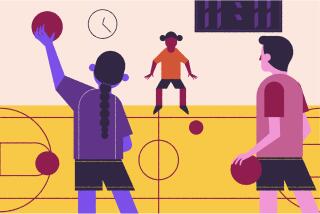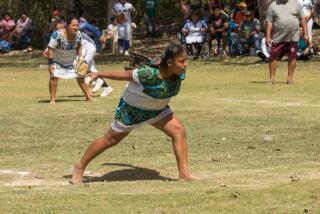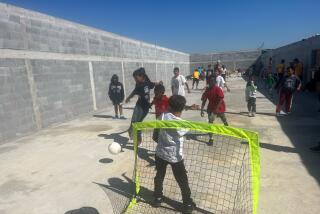THINGS PEOPLE DO : SEPAK TAKRAW : Imagine Playing Volleyball Without Your Hands, and You Get an Idea of What This Southeast Asian Sport--Translated as ‘Kick Woven Ball’--Is All About
SAN DIEGO — Days were long, tempers were short, and boredom was something you could never completely escape in a Thai refugee camp.
Thousands risked life and limb to escape the Communist regime that took over Laos in 1975. But they had to wonder if a two-year stay in the refugee camps, where conditions were often harsh, was much better than the life that had awaited them under the new Laotian government.
To help pass the time, some found solace in reading, some in song and some in a sport called sepak takraw.
“They’d get so bored in those camps,” said Kurt Sondergger, who founded the U.S. Sepak Takraw Assn. in March. “They’d play and play. A lot of people in those camps were players, good players, and they knew each other from the sport.”
Sepak takraw is a game played primarily in Southeast Asia, but it is fast gaining popularity in Japan, India, Germany and the Fiji Islands. While there is no organized club here, San Diego claims some of the best players in the nation. One is Sam Phonesavanh.
A shy man who chooses his words carefully, Phonesavanh transforms his temperament on a sepak takraw court. There, he scampers to make diving saves, twists himself into a pretzel to make routine kicks exciting and somersaults his body on kill plays at the net.
His zeal for the game mirrors his attitude toward life. After three unsuccessful escape attempts, Phonesavanh and a younger brother spent a harrowing night crossing the Mekong River, the western boundary dividing Laos and Thailand, in 1978. They lived in a refugee camp for 18 months.
“We played for at least five hours a day in camp,” said Phonesavanh, 30. “It helped to make the day go fast. If you didn’t find something to take up your time, all you thought about was how long you had been there.”
During that time, Phonesavanh returned to Laos for his mother, a sister and two other brothers. His mother made it, but his sister drowned in the river, and the brothers returned to Laos, where they now live with an aunt.
In 1981, after spending six months in the Philippines, Phonesavanh, his mother and younger brother arrived in San Diego. Since then, Phonesavanh has found approximately 200 sepak takraw players in the Laotian and Asian communities of San Diego. Several Americans have expressed interest in the sport, but few are successful.
“They’re interested,” he said, “but it’s very hard for them. It is a difficult game. And the ball is too hard.”
Although the United States has been represented only once in international competition--in the King’s Cup, one of takraw’s most prestigious events--Sondergger said he thinks Americans have the tools to become adept at the sport.
“Takraw players are mostly foot bag or soccer players,” he said. “I think we can be really good. We’re taller than the Asians, and that’s an advantage. Americans are getting to know their feet better because soccer is exploding, and it could be a great cross-trainer for them. They’re using many of the same skills, and it would help them not to get bored.”
Two years ago, Sondergger organized the largest sepak takraw tournament in this country. It was held in Santa Monica and offered $2,000 in cash and prizes. In the 18-team event, Phonesavanh and his partners, Dave Soummabong and Vivi Vongphrachanh, finished first, usual for them in the half-dozen events they enter each year.
“They’re the best,” said Sondergger, who is now planning “Spike Fest 90” for Santa Monica in September. “They win every time. Other teams have more dynamic spikers, but they’re so smart, no one’s been able to beat them.”
Since takraw is still in its infancy, the available tournaments are few. Most events are held in conjunction with Malaysian or Thai cultural festivals.
While one of Phonesavanh’s goals is to organize a club in San Diego, time and financial resources are limited.
“All my friends, we work all day,” he said. “And Asian people are too shy to ask for (financial) help to start a club. That is the way of Asian people.”
Phonesavanh and his friends play informal games in North Park and Linda Vista, but because court space is difficult to come by, they often play in players’ back yards.
Sondergger said takraw isn’t catching on as quickly in San Diego as it is in Los Angeles because a small contingent plays in isolated areas, and because most Laotians are shy.
“They play in small parks,” he said. “And they don’t know how to answer questions. They don’t talk to people, invite them out to play. I’m trying to help bridge that gap.”
San Diego is slowly crossing the bridge. There was an eight-team tournament in San Diego in April, and this year the local contingent has demonstrated the sport at the women’s pro beach volleyball event in Pacific Beach and at a convention in Mission Valley. And wherever they play, curious onlookers line the court.
“They always ask what we are doing,” he said. “We will teach teach them if they like to learn.”
Sepak (which means “kick” in the Malay language) takraw (which means “woven ball” in Thai) simulates the bump-set-spike strategy of volleyball, but like soccer or foot bag (also known as Hacky Sack), the use of the hands or arms is prohibited. A team consists of three players--a center and two forwards--and a fourth player can rotate in at any time.
Scoring is similar to that in volleyball. The ball can be hit three times by each team, but unlike volleyball, a player can hit the ball more than once. When the ball hits the ground or goes out of bounds, a point or a side-out is awarded.
The ball is either plastic or rattan and is less than half the size of a basketball. The court is similar in size to a badminton court, and the net is 5-feet-1 high.
The exact origin of the sport is unclear, but it was played by members of royalty in India as early as the 11th century. The Philippines, Thailand and Malaysia all claim it, but there is documentation in Malaysia that the Malaka Sultanate was playing it in the 1400s, when it was call sepak raga and played as a circle game.
By 1945, the introduction of a net had revolutionized the game--although it can still be played in a circle, especially for beginners--and in 1966, the name was changed to sepak takraw.
In 1987, while working in Switzerland, Sondergger’s interest in the sport was piqued. After spotting a fellow foot bag player kicking around a takraw ball to keep in shape, he was so intrigued that he traveled to Thailand to get a first-hand glimpse of the game. Soon after, he moved to California to introduce the sport to America.
“I decided to move to the West Coast,” he said. “Southern California seemed the best-suited place to start it because of the high concentration of Asians, the climate, and to hook up with some Americans that already knew how to play,” he said.
Northrop (Calif.) University and UCLA are the only places Sondergger knows that offer organized takraw. Northrop’s program is sponsored by Malaysian Airline System.
Sondergger is the owner of Oriam Sport, a company that markets the only takraw ball manufactured in the United States. These yellow neon and black plastic balls, distributed under the name Buka Ball, are softer than the rattan balls originally used and available at Sports Chalet on Midway Drive for $12.95.
Through the efforts of people such as Sondergger, the 10-year old Asian Sepak Takraw Assn., based in Bangkok, is now called the International Sepak Takraw Assn.
“We’re trying to promote it as a world sport, not just an Asian sport,” said Sondergger, who estimated it will take 12 to 15 years for takraw to become a medal sport in the Olympics. “We’re trying to work with the U.S. Olympic Committee to get it recognized.”
Malaysia and Thailand claim takraw as their national sport, and it is popular in surrounding countries such as Singapore, the Philippines and Indonesia. Sondergger said it is probably equally popular in Laos, Mylammar (formerly Burma) and Cambodia, but they don’t compete internationally because of the political climates. For the first time, sepak takraw will be a medal event in the 1990 Asian Games in Beijing.
According to Sondergger, who has done extensive research on the game, the Thais--world champions the past two years--used to play a less aggressive one-on-one game. It was the Malaysians who modernized it by introducing the three-player, three-kick format.
The USSTA is conducting a membership drive though the sale of takraw balls. Inside the Buka Ball packaging is a list of rules and instructions on various kicks and how to play. Buyers are encouraged to fill out cards and return them to Oriam Sport to build membership in the USSTA and possibly start clubs in cities throughout the country.
More to Read
Go beyond the scoreboard
Get the latest on L.A.'s teams in the daily Sports Report newsletter.
You may occasionally receive promotional content from the Los Angeles Times.










